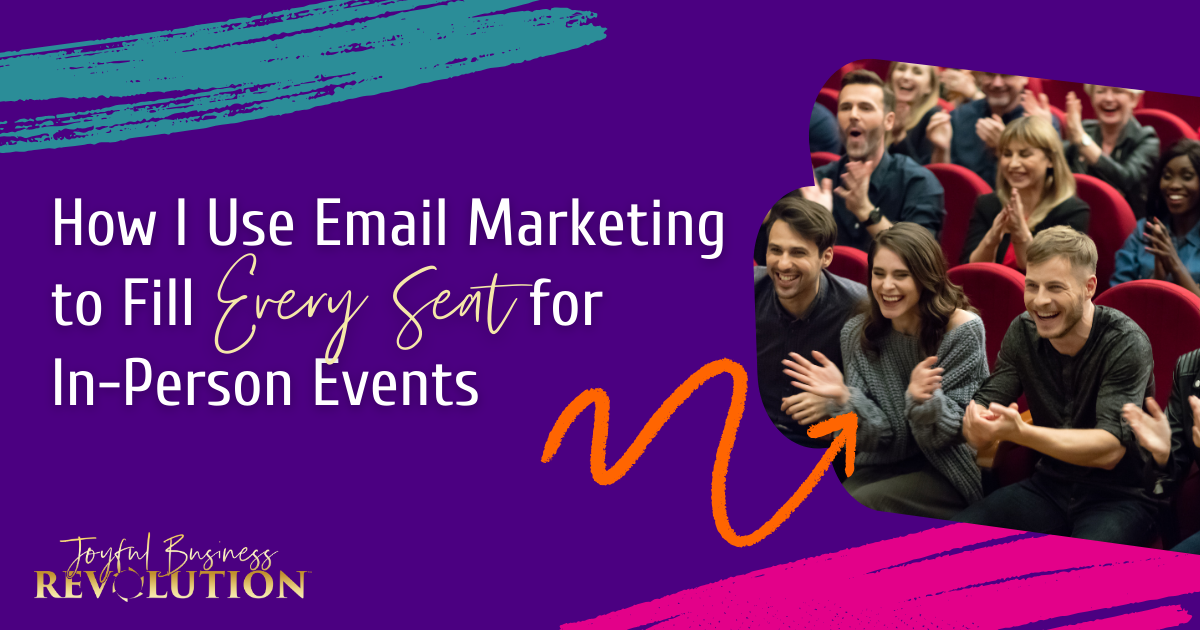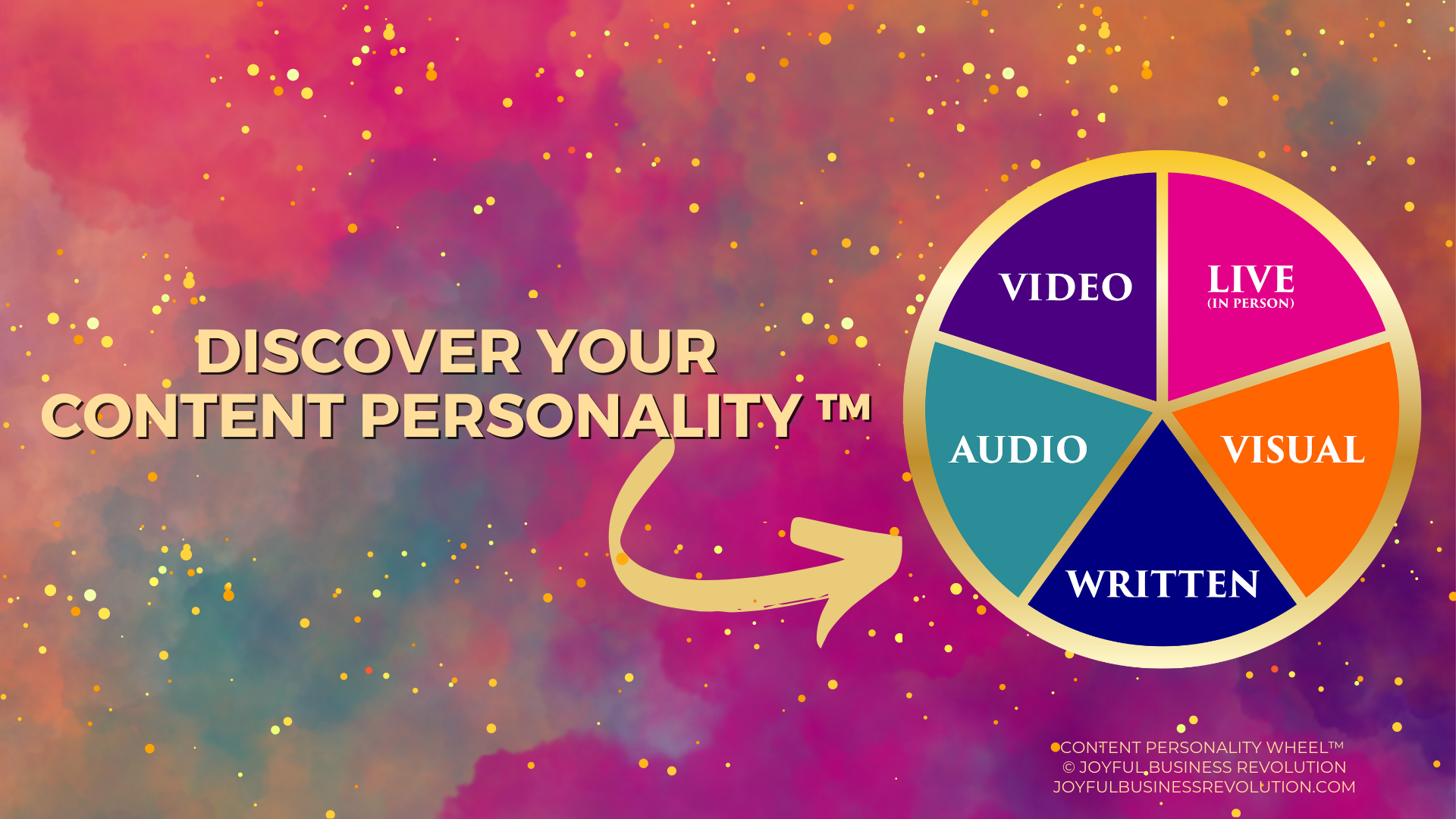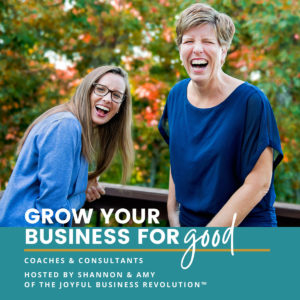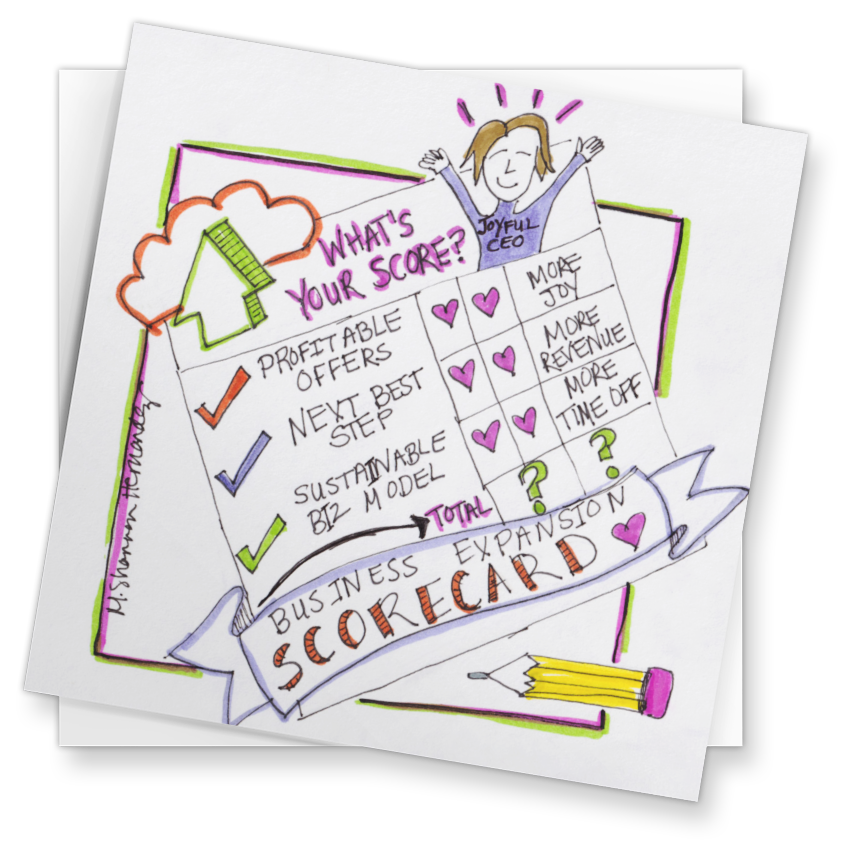Hosting an in-person event your audience talks about for years starts with building a genuine connection with your audience and deepening that relationship significantly well before the event. And that means understanding what they want and how to reach them so you can fill those seats.
You might be wondering, “How can I use email marketing to sell out my in-person events and excite my audience ahead of time?
Amy and I have been selling out in-person events for years. While that slowed down a bit during the pandemic—as it did for everyone—live events are back! And better yet, we’re back in the swing of hosting and promoting several each year.
In addition to hosting workshops in every location we speak—almost a dozen a year—we also host two in-person Joyful Business Revolution events each year. And they sell out nearly every time!
Before giving you a peek behind the curtain, I want to be super clear about three things:
#1: We are talking about live, in-person events. People are together in a room. Humans are interacting in a community. And that could mean a conference, retreat, workshop, or mastermind. More about online events in my next article…
#2: It’s never just about putting butts in seats! I want to make sure that we’re filling the room with the right energy—people who really want to be there with Amy and me, any of our speakers or co-hosts, and everyone else in the room. When you come to one of my events, I want your whole self with your heart, your soul, and not just your butt cheeks!
#3: It’s about people, not numbers. Sure, if you have 50 seats to fill, you need more than 50 people on your mailing list, but you don’t need tens of thousands of names. And you don’t need ads!
My goal has never been to “build a list.” I want relationships with everyone who signs up to get emails. And that’s what Amy and I have done. Over the last decade, we have built relationships with each of the 4,500 amazing humans on our list without spending a penny on ads! Those relationships have set the stage for email marketing to promote our events.
Wondering how we grow our list by about 10% quarter after quarter? It’s with our Content Personality® Quiz, designed to help you understand how to use your natural strengths to create marketing content and maximize your time and energy. Take the quiz here!
Now that you know my philosophy on email marketing as a whole, it’s time to dig into how to use it effectively to promote your events.
The Role of Email in a Holistic Event Marketing Strategy
Email marketing means I can fill seats for our fall event and still go offline for a few weeks to hike 80 miles of the El Camino without opening my email because the strategy is in motion—and I trust it. (You must learn to create a predictable strategy you trust, too.)
Email marketing is my love language. It allows me to live my life offline and off of social media, so it should come as no surprise that email is central to my event marketing strategy. In fact, we use email marketing exclusively for event promotion and sales.
And yes, I do use social media, but I don’t have to live or rely on it!
If you have only one takeaway from this article, it should be using email as a two-way communication tool yields much better results. Shifting your mindset from talking at people to talking with them allows you to create a conversation and, in turn, a relationship. The better that relationship, the better your sales.
Email marketing is a critical part of your event marketing strategy, or it should be. However, you need a well-defined and intentional strategy based on your event timeline and goals, list size, and degree of tagging and segmentation.
Using Email for Broad Outreach and Zeroing In
Email marketing for events allows you to reach your entire audience for broad awareness, while also giving you the power to zero in on specific segments or regions. Your event email marketing strategy can and should accommodate both.
For example, I’m speaking in Chicago soon, and one of our community members is hosting me for a workshop. We can share both events with the main list if they know someone or may be traveling to the area. We can also drill down to a specific geographic region and reach out to people with Chicago area codes or whose zip code lies within a few hours of Chicago.
Depending on your list segmentation strategy, you might zero in based on industry, interest, or another offer they’ve purchased.
Keep in mind, as you build your event email marketing strategy, you certainly could use these tips for online events, but this advice primarily focuses on event organizers and marketers planning:
- Conferences
- Seminars
- Retreats
- Workshops
- Masterminds
- And other in-person events
But what should your strategy look like? What emails should you be sending? And when?
As you read through this if you find yourself wondering where to begin, you don’t have to do it alone. Set up a call with Amy for help finding the best path forward.
Emails to Send Before, During, and After Your In-Person Event
The emails you send should depend on your audience, your event, and event timing. The reality is that most people don’t start marketing their events soon enough.
As soon as you have a date and a location, even if you don’t have pricing or an agenda, start spreading the word. Put it on your website and social media. And remember, you can develop your schedule as you go, using those updates to build interest and secure ticket sales.
Why do we start so early? People need time to plan, whether getting childcare or moving clients and appointments, not to mention flights and hotels. So give them the luxury of planning.
Pre-Event Email Marketing Strategy
You can start marketing your event before you even have firm plans using what we call a hand-raiser campaign or a short email to your audience to gauge interest. Mine say something like:
“Hey! I’m thinking about hosting an event in April around story and using story to sell. Would you be interested?”
These campaigns validate your idea and interest and help you develop a personal outreach list. Once you’re ready to start selling tickets, this is the first group of people you should reach out to.
Your First Event Sales Emails
As soon as you have pricing, start talking about the event with a personal outreach campaign to your personal outreach list. Our strategy is to give the folks who raised their hands the first crack at tickets and get the first handful of ticket sales in the door.
But it’s not just about selling tickets.
Personal outreach emails are just that—personal. Even though there’s so much focus in the toxic online space about reaching MORE people, it’s not always about being visible to the most people possible. Instead of sending these out as a mass campaign from your email marketing platform, send these individually and personalize each email!
We see event sales as heartfelt as inviting someone to your house for dinner. And you absolutely want the right people in the room—people who are going to get along and who are going to enjoy each other and the experience. Remember, we don’t want butts in seats. We want the right energy and your whole self.
Start by identifying 25 people from your personal outreach list and your Rolodex and sending them a personal invitation to buy tickets at the best possible price. I like to give people a two-week window so they have plenty of time to decide if the logistics are doable and get their ducks in a row. This might be early bird pricing, or you might call this your early access campaign and offer limited access at an even lower price.
After your personal outreach campaign, open up the registrations to the rest of your list. You may want to offer a secondary early-bird offer with slightly higher pricing than your individualized invites.
Whatever you choose, make sure your message, strategy, and email tagging is on point.
Moving from Early Bird to Late Bird
After your early bird campaign ends, it’s time to shift to “late-bird” mode, sending ongoing emails that complement your other content. Some emails should be exclusive to event promo, while others can mix up the other types of content you’re delivering—blogs, podcasts, etc.
You can also start varying this by the audience, drilling down to different groups, whether by geography or interest, with a message personalized to their interests.
Keep Building Momentum Towards Your Event
As you have newsworthy information to share, use it to build excitement about your event and throw in some fun, creative ideas to get people excited and boost event attendance! Remember, you’ve got to find interesting angles to keep talking about your event. Not doing it is a missed opportunity.
Some of my favorite email marketing ideas for events?
- 5 reasons you should attend this event
- Sneak peek of the venue
- Get to know the speakers-
- The snacks you’ll get (haha, huge snack person here!)
- 65 ideas to [something you can help them with]
A word to the wise: don’t over-email. Keep it to a cadence your audience likes and expects.
Remember to do a Last Call Campaign
Email countdown campaigns are perfect for people who are on the fence or waiting on some key logistics piece.
I usually list ten reasons you want to attend our events—one per day. Reason #10 goes out on Monday with a short email, maybe an eye-catching graphic, and a call to action. That consistency and pattern disruption make people take notice because I don’t usually send emails that often, and people realize something exciting is happening.
Watch Your Email Stats
Make sure you’re paying attention to email performance for every campaign you send, including any automated sequences. You’re looking for information like:
- Which emails are performing better
- Who is opening the emails
- Who is clicking the link and not purchasing
Clicker campaigns allow you to follow up and invite your audience to ask questions. Personally, I love inviting them to grab a time on my calendar so we can have a Zoom chat to go through their goals and dreams, as well as address any questions about logistics.
These conversations also give you great information about the objections people have so you can adapt messaging moving forward.
Other Pre-Event Campaign Ideas
If you’re looking for more campaign ideas tied to the event, you might also consider:
- A call for speakers announcement
- A final call for speakers reminder
- Emails asking for sponsors and announcing sponsors
- Room block expiring
These aren’t usually part of our events, but they can be great ways to get in front of your audience and build buzz around your event.
Pre-Event Email Marketing Ideas And When to Send Them:
We’ve touched on a ton of email types so far, so I wanted to give you a quick summary of what we’ve covered here. While these aren’t event email marketing templates, per se, you can get a good idea of what you should be sending and when.
Hand Raiser Email Campaign
What it is: A short email to your list to find out who is interested.
Why it’s important: Validate your event and build your personal outreach list.
When to send: When you have a ticket price and open doors.
Emails to send: just the one short email
Personal Invite Email Campaign with Early Bird Pricing
What it is: A personal note to the 25 people you want to see at the event based on your personal outreach list and Rolodex contacts.
Why it’s important: It helps you build momentum and get the first ticket sales.
When to send: As soon as you have pricing.
Emails to send: At a minimum, an announcement email, a reminder email, and a last-chance email.
Early Bird Email Campaign to Main List
What it is: A two-week series of emails to your main list after your personal invite campaign announcing the event. Depending on your event email marketing strategy, this may include additional early bird savings.
Why it’s important: It opens up the event to the main list after the hand-raisers have had the opportunity to purchase.
When to send: As soon as the personal invite campaign wraps.
Emails to send: At a minimum, an announcement email, a reminder email, and a last-chance email.
Ongoing / Late Bird Email Campaign
What it is: These are part of your ongoing event promotion following the early bird promotion.
Why it’s important: Continues building excitement about your event
When to send: On your regular cadence. Mix in with the other content you share.
Emails to send: Ongoing campaigns based on some of the ideas I’ve shared above.
Location Email Campaign
What it is: A short email letting local-ish people know you’ll be in an area and don’t know when you’ll be back.
Why it’s important: It feels like a personal invite (it can be personal or mass, depending on the size of your list).
When to send: Periodically based on your event promotion timeline and ticket sales.
Emails to send: One email at a time.
Countdown Email Campaign
What it is: A 10-email series that gives people reasons to attend.
Why it’s important: These are daily, which disrupts the pattern, and makes people take notice.
When to send: Right before closing ticket sales
Emails to send: 10 short, sweet emails with a CTA.
Clicker Follow-Up Email
What it is: A personal email to someone who has clicked and not bought to follow up.
Why it’s important: It offers them the opportunity to ask questions and get to know you better.
When to send: 3-5 days after sending a mass email campaign.
Emails to send: A single email.
Swipe & Promo Content
If you’re hosting an event and bringing speakers in, the earlier you can send out swipe and promo content, the better. The longer it takes, the less likely people will promote your event. If you can have it a month out, that’s ideal. Sharing it less than a week out guarantees fewer eyes on it.
Upsell Emails
We do not upsell before, during, or after our event! It’s not the purpose. And everyone who attends our event is a VIP. There’s no VIP access to Amy and me and no VIP tier. Everyone is here to spend time with us and the others in the room, so no one in our event receives anything less.
Using Your Email List During the Event
We believe that the moment you buy the ticket is the moment the event starts—and that’s very different from what many other event hosts do/believe. Instead, we’re building that anticipation before you get there.
Post-Purchase Pre-Event Emails to Send
Some of our favorite ways to engage people are sending fun emails as we nail down more details and regular updates about five weeks out to keep the excitement building. Those emails might include homework or a request for a short reply.
We also match people up with partners ahead of time who interview each other online before the event. More importantly, they already know someone when they walk in that door! As an introvert, I wish EVERY event host did just this one thing!
So what could your homework look like? Here are a few ideas
- Five weeks out — send in your travel plans so we can watch your flights and plan for your arrival.
- Four weeks out — send your two favorite songs to help us build a playlist.
- Three weeks out — interview your partner using these three questions.
- Two weeks out — what’s one thing you hope to walk away with?
- One week out — share what you’re most excited about.
Using Emails Onsite
We don’t typically use emails onsite. When we’re with our people, we’re with our people, and we can always reach them via phone call or text. And yes, this is about email, but during the events, we’ll use social media to share a handful of pictures for people who aren’t with us.
We use a CTA on these posts so people can let us know if they’re interested in early information about the next event. We then use these to build our personal outreach list for the next event.
But there are definitely some events—especially larger ones—where emails can come in handy. Here are some during-event email marketing examples:
- Daily event agenda
- Any last-minute event updates
- Sneak peeks to your main list
- Sponsored emails during the event
After-Event Follow Up Emails
Everyone has a slightly different style here. Our vibe centers on gratitude and joy—we’re so grateful for the people we just got to spend time with and want to spread the joy to others. So, our favorite post-event emails are all about sharing the love.
Thank You Emails
Everyone gets a simple thank you email after they get home and have time to get back in the swing of things. I love to include pictures of the event, screenshots of social posts, and first access to the next event for less than the early bird price.
Event Recap Emails
After getting the photography back, it’s time for a recap series of three to four emails to the main list that cover things like:
- What attendees said
- Fun pictures
- Takeaways
Each has a single CTA: get on the interest list. Once people are on the interest list, they won’t get these because it keeps the emails they are getting to a minimum.
The Cycle Begins Again
After that, we’re planning our future events and going through the emails listed above in the pre-event section, starting with personal outreach and early-bird campaigns to kick off event registration.
More After-Event Follow-Up Emails
I’ve shared my favorite after-event emails to send, but based on your business, you may have other needs. Some other emails that I’ve gotten after attending conferences, workshops, and other events that have added value include:
- Emails with resources like links, recordings, and handouts after the event so people don’t have to scramble with detailed notes.
- Emails announcing curated events that I might be interested in
- Emails with a list of attendees so I can follow up with people (with a hardline agreement to not add people to lists without permission)
Filling Events Starts with Knowing Your List
I said it above, and I’ll say it again. Email marketing is about two-way communication and relationship building. That should be your #1 goal—yes, even before you think about filling your events.
That means you have to know your list and spend some serious time on tagging and segmentation. You don’t want to send registration emails to anyone with a ticket to your event. And you don’t want to ask people on your interest list to raise their hands—they’ve already raised them.
The tighter your tagging game, the better you can target your emails and the more likely you are to fill those events.
And a final reminder—you still need to follow email marketing best practices and make sure your emails sound like you!
If this all sounds like a lot, it can be, but once you build your event email marketing ecosystem and know how to play to your strengths, it gets much easier to manage.
And we can help you make it even easier!
- Our Content Personality® Quiz will reveal your natural marketing strength so you can simplify your marketing, deepen relationships with your community, and double your revenue.
- Want our help creating a robust email marketing strategy that helps you deepen relationships and double revenue? Let’s gather for a Business Growth Strategy Session. You can find a date and time that works for you here.
Would you like to dive deeper into email marketing–and how to make it work better for your business?
Season 5 of our podcast, Grow Your Business for Good, is all about email marketing and a great next step–if you enjoy listening to podcasts packed with value–and JOY!
You can also read more in this series on Email Marketing for Coaches and Consultants. You can find the entire series linked below: –
- The Art of Connection: An Email Marketing Playbook for Coaches
- How I Use Email Marketing to Fill Every Seat for In-Person Events
- Email Marketing Mastery for Webinar Hosts: Tips, Tricks, and Sequences
- The Business Benefits of Newsletters (+ When to Be Wary)
- Lead Nurturing Email Sequences: The What, the Why, and the How
- Best Email Marketing Platform for Solopreneurs [2024]





